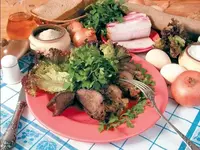The yugoslavian

Yugoslav cuisine, like the country of Yugoslavia itself, is unique. Enough time has passed since such an independent state as Yugoslavia disappeared from the political map of the world.
The country lasted almost 100 years on the Balkan Peninsula. Nowadays, several original peoples who live in independent states in the territory of the former Yugoslavia - Slovenia, Macedonia, Montenegro, Croatia, Serbia, Bosnia and Herzegovina - prepare their dishes according to the recipes of Yugoslav cuisine.
To talk about Yugoslav cuisine, first you need to name some features of the culinary traditions of the inhabitants of the Balkans. In the former Yugoslavia, as in the current independent republics, meat dishes are incredibly popular.
Yugoslavs use pork, lamb, as well as poultry meat in the recipes of Yugoslav cuisine. Yugoslav cuisine is characterized by the use of fish, a large amount of fresh vegetables, as well as spices and seasonings.
In addition to ingredients, Yugoslav cuisine differs in cooking methods. For example, a tarator or guvechi, a bath house and others. Often, Yugoslavs bake pies and other bakery products, in which they certainly add tar or pork fat.
The obligatory general Balkan ingredient in most recipes of Yugoslav cuisine Kaymak. Kaymak is a milk film that forms after the milk is boiled. So the Yugoslavs collect the film and fold it from special pots in layers that periodically salt. The more Kaymak insists, the better he gets.
Usually a traditional Yugoslav meal starts with light snacks. Yugoslav peoples like to start eating with sausages. For example, hard smoked sausage or ham Uzichka prshut, which is smoked at home. Sausages are necessarily served with sweet peppers, it is believed that this is how the taste of sausage improves.
Among the first dishes of Yugoslav cuisine are the famous bean soup or sauerkraut soup. Yugoslav soups are distinguished by their thick consistency, so they are often served as their own second dish with bread. Often, Kakawal cheese with sauce or seafood risotto is served to the soup "for the second. "
Among the recipes of Yugoslav cuisine can be noted the famous meat dishes Chevapchichi or Shish chaval. The first dish of Yugoslav cuisine is sausages of finely chopped meat, and Shish chaval is lamb, which is marinated in spices and then baked on charcoal. Yugoslavs like to bake meat dishes over an open fire.
On holidays, they make a traditional dish of Yugoslav cuisine - a young pig on a spit. Often meat dishes are served with a side dish of stewed vegetables. Fish are in demand in Yugoslavia. On the coast, fish is baked with rice, river fish is also fried or soup is boiled from it, baked or dried. Usually rice, vegetables (potatoes, sour cabbage) or porridge (corn polenta) are served as a side dish on Yugoslav feasts.
In Yugoslav cuisine, all dishes are abundantly seasoned with spices and spices. In almost all recipes of Yugoslav cuisine, you will find an ingredient such as red pepper and garlic. Tomatoes are very popular in Yugoslavia, they are stuffed, added to salads and other meat dishes.
Juvech is a popular Yugoslav dish that is a team of solyanka from meat, vegetables, rice. All ingredients are mixed and stewed, not forgetting to pepper abundantly, salt and add spices. For dessert in Yugoslavia, Feta cheese from sheep's milk or hard Kachkaval cheese is served.
You will also always be able to taste beautiful Yugoslav pastries and flour sweets. Desserts in Yugoslavia are usually combined with dry red or white wine. Among the national Yugoslav drinks are the world famous Maraskino (from cherry) and Slivovitsa (based on plums).
 Español
Español Français
Français Português
Português Русский
Русский 简体中文
简体中文 繁體中文
繁體中文 日本語
日本語 한국어
한국어 العربية
العربية Türkçe
Türkçe Қазақ
Қазақ Deutsch
Deutsch Italiano
Italiano Українська
Українська
